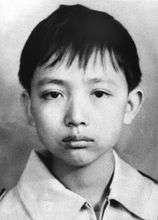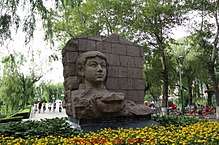Lai Ning
Lai Ning (Chinese: 赖宁; pinyin: Lài Níng; 20 October 1973 – 13 March 1988) was a teenage schoolboy in China, who died while fighting a forest fire in Shimian County, Sichuan. Lai Ning's actions were deemed heroic by the Chinese government and Lai has been celebrated as a hero and martyr in contemporary China.
Lai Ning | |
|---|---|
赖宁 | |
 | |
| Born | 20 October 1973 |
| Died | 13 March 1988 (aged 14) |
| Nationality | Chinese |
| Known for | Death while fighting a forest fire |
| Lai Ning | |||||||
|---|---|---|---|---|---|---|---|
| Traditional Chinese | 賴寧 賴甯 | ||||||
| Simplified Chinese | 赖宁 | ||||||
| |||||||

Personal life and death
Lai Ning was a fourteen-year-old schoolboy living in Shimian County where he was regarded as a loner by his classmates, and, for reporting their infractions, a "snitch."[1][2] On March 13, 1988, a wildfire was threatening a nearby forest and schoolchildren were mobilized to help fight the fire. Lai voluntarily assisted the firefighting efforts for five hours.[3] Lai was eventually overcome by the flames and killed in the fire.[4]
Legacy
Lai Ning was later declared a "revolutionary martyr" by the Chinese government for his role in combating the wildfire to protect his town.[1] Over the next year, his story was used increasingly in Chinese propaganda as a model of courage and duty for Chinese youth. This was especially important in the aftermath of the 1989 Tiananmen Square protests when the Chinese government hoped to gain support from Chinese teenagers and promote an alternative example of youth in China.[1] Deng Yingchao declared that "only by plunging into studies of Lai Ning can you become the sound new masters of your country in the 21st century" in the People's Daily.[2]
Since that time, Lai Ning has been commemorated with posters in school classrooms and statues in town squares. In the 1990s, Lai's story was taught in Chinese textbooks to teach students about the importance of protecting Chinese society.[5] The propaganda surrounding Lai Ning was sometimes poorly received within China, and some teachers believed that the calls for emulation were outdated tactics from the Cultural Revolution era.[2]
A miniseries depicting Lai Ning's life was aired in the years following his death and a film was released in 1993.[2][6]
References
- "Lai Ning". Chinese Posters. chineseposters.net. Retrieved 11 September 2017.
- Kristof, Nicholas D. (2 November 1990). "Beijing Journal; China's Schoolboy Hero: Lesson Is Lost on Many". The New York Times Company. New York Times. Retrieved 14 September 2017.
- "Lai Ning:a 14-year-old hero". CPC Encyclopedia. China Daily Information Co. Retrieved 11 September 2017.
- 吕, 妍 (22 December 2004). "赖宁奋不顾身扑山火". 东北邮局. 省社会科学院. Archived from the original on 3 August 2012. Retrieved 11 September 2017.
- 李, 朝全 (11 June 2012). "赖宁这个精神符号过时了吗". 中国青年报. China Youth Daily. Retrieved 11 September 2017.
- "赖宁 (1993)". 豆瓣电影. douban.com. Retrieved 14 September 2017.
Further reading
- Remembering Lai Ning Editorial Committee, Remembering Lai Ning (Peking: Xueyuan chubanshe, 1990) [in Chinese]
- Robert Tanner, "Lei Feng and Lai Ning: The Search for Ideological and Moral Models in New China", Wittenburg East Asian Studies Journal, vol. 16 (1991), pp. 105–113